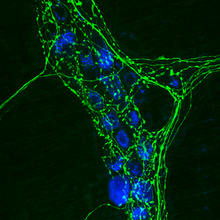Immunocytochemistry

This article needs attention from an expert in Molecular and Cellular Biology. Please add a reason or a talk parameter to this template to explain the issue with the article. (February 2009) |
Immunocytochemistry (ICC) is a common laboratory technique that uses antibodies that target specific peptides or protein antigens in the cell via specific epitopes. These bound antibodies can then be detected using several different methods. ICC allows researchers to evaluate whether or not cells in a particular sample express the antigen in question. In cases where an immunopositive signal is found, ICC also allows researchers to determine which sub-cellular compartments are expressing the antigen.
Immunocytochemistry vs. immunohistochemistry
Immunocytochemistry differs from immunohistochemistry in that the former is performed on samples of intact cells that have had most, if not all, of their surrounding extracellular matrix removed. This includes cells grown within a culture, deposited from suspension, or taken from a smear. In contrast, immunohistochemical samples are sections of tissue (biology), where each cell is surrounded by tissue architecture and other cells normally found in the intact tissue.
Methods
There are many methods to obtain immunological detection on tissues, including those tied directly to primary antibodies or antisera. A direct method involves the use of a detectable tag (e.g., fluorescent molecule, gold particles, etc., ) directly to the antibody that is then allowed to bind to the antigen (e.g., protein) in a cell.
Alternatively, there are many indirect methods. In one such method, the antigen is bound by a primary antibody which is then amplified by use of a secondary antibody which binds to the primary antibody. Next, a tertiary reagent containing an enzymatic moiety is applied and binds to the secondary antibody. When the quarternary reagent, or substrate, is applied, the enzymatic end of the tertiary reagent converts the substrate into a pigment reaction product, which produces a color (many colors are possible; brown, black, red, etc.,) in the same location that the original primary antibody recognized that antigen of interest.
Some examples of substrates used (also known as chromogens) are AEC (3-Amino-9-EthylCarbazole), or DAB (3,3'-Diaminobenzidine). Use of one of these reagents after exposure to the necessary enzyme (e.g., horseradish peroxidase conjugated to an antibody reagent) produces a positive immunoreaction product. Immunocytochemical visualization of specific antigens of interest can be used when a less specific stain like H&E (Hematoxylin and Eosin) cannot be used for a diagnosis to be made or to provide additional predictive information regarding treatment (in some cancers, for example).
Alternatively the secondary antibody may be covalently linked to a fluorophore (FITC and Rhodamine are the most common) which is detected in a fluorescence or confocal microscope. The location of fluorescence will vary according to the target molecule, external for membrane proteins, and internal for cytoplasmic proteins.In this way immunofluorescence is a powerful technique when combined with confocal microscopy for studying the location of proteins and dynamic processes (exocytosis, endocytosis, etc).
